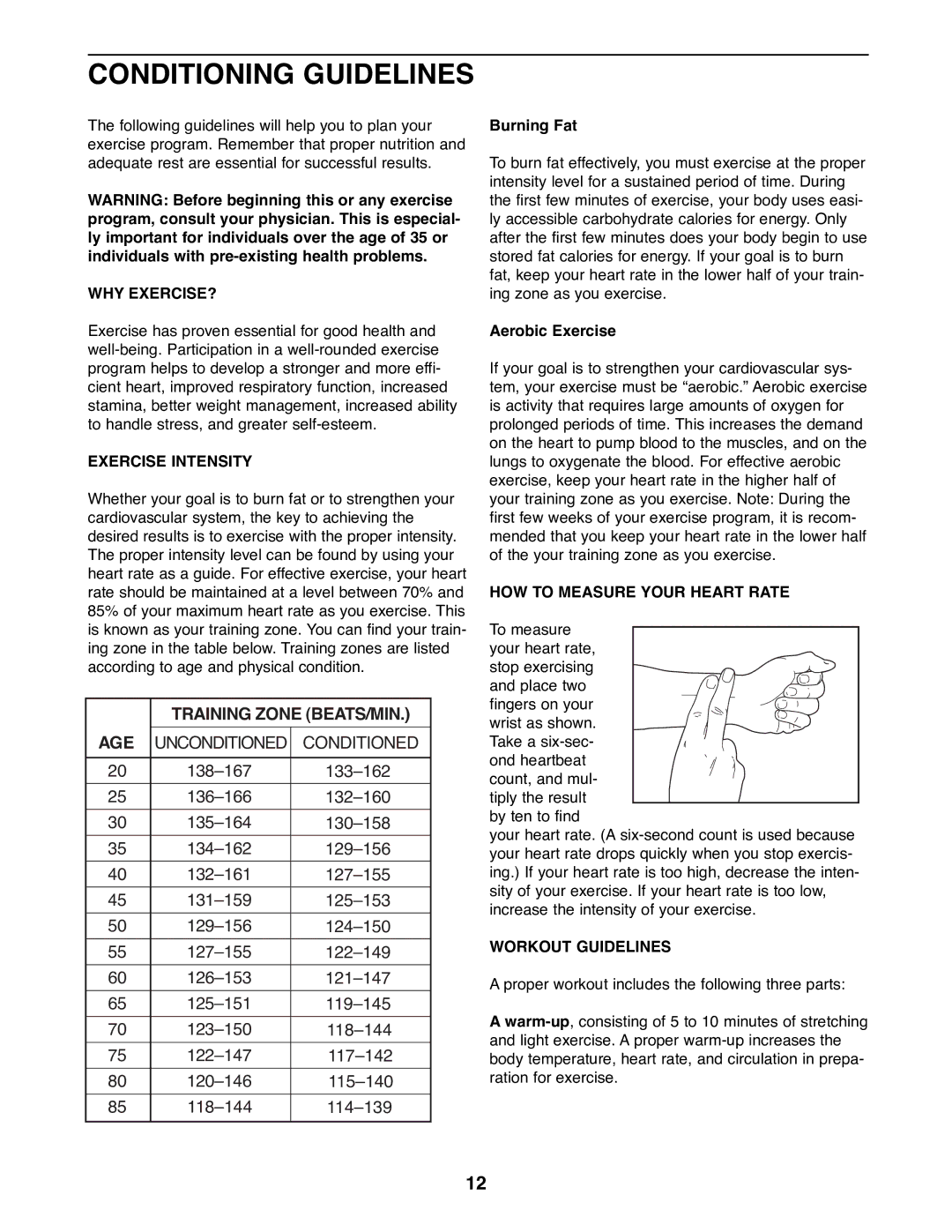
CONDITIONING GUIDELINES
The following guidelines will help you to plan your exercise program. Remember that proper nutrition and adequate rest are essential for successful results.
WARNING: Before beginning this or any exercise program, consult your physician. This is especial- ly important for individuals over the age of 35 or individuals with
WHY EXERCISE?
Exercise has proven essential for good health and
EXERCISE INTENSITY
Whether your goal is to burn fat or to strengthen your cardiovascular system, the key to achieving the desired results is to exercise with the proper intensity. The proper intensity level can be found by using your heart rate as a guide. For effective exercise, your heart rate should be maintained at a level between 70% and 85% of your maximum heart rate as you exercise. This is known as your training zone. You can find your train- ing zone in the table below. Training zones are listed according to age and physical condition.
| TRAINING ZONE (BEATS/MIN.) | |
AGE |
|
|
UNCONDITIONED | CONDITIONED | |
|
|
|
20 | 138Ð167 | 133Ð162 |
|
|
|
25 | 136Ð166 | 132Ð160 |
|
|
|
30 | 135Ð164 | 130Ð158 |
|
|
|
35 | 134Ð162 | 129Ð156 |
|
|
|
40 | 132Ð161 | 127Ð155 |
|
|
|
45 | 131Ð159 | 125Ð153 |
|
|
|
50 | 129Ð156 | 124Ð150 |
|
|
|
55 | 127Ð155 | 122Ð149 |
|
|
|
60 | 126Ð153 | 121Ð147 |
|
|
|
65 | 125Ð151 | 119Ð145 |
|
|
|
70 | 123Ð150 | 118Ð144 |
|
|
|
75 | 122Ð147 | 117Ð142 |
|
|
|
80 | 120Ð146 | 115Ð140 |
|
|
|
85 | 118Ð144 | 114Ð139 |
|
|
|
Burning Fat
To burn fat effectively, you must exercise at the proper intensity level for a sustained period of time. During the first few minutes of exercise, your body uses easi- ly accessible carbohydrate calories for energy. Only after the first few minutes does your body begin to use stored fat calories for energy. If your goal is to burn fat, keep your heart rate in the lower half of your train- ing zone as you exercise.
Aerobic Exercise
If your goal is to strengthen your cardiovascular sys- tem, your exercise must be Òaerobic.Ó Aerobic exercise is activity that requires large amounts of oxygen for prolonged periods of time. This increases the demand on the heart to pump blood to the muscles, and on the lungs to oxygenate the blood. For effective aerobic exercise, keep your heart rate in the higher half of your training zone as you exercise. Note: During the first few weeks of your exercise program, it is recom- mended that you keep your heart rate in the lower half of the your training zone as you exercise.
HOW TO MEASURE YOUR HEART RATE
To measure your heart rate,
stop exercising and place two
fingers on your wrist as shown. Take a
your heart rate. (A
WORKOUT GUIDELINES
A proper workout includes the following three parts:
A
12
